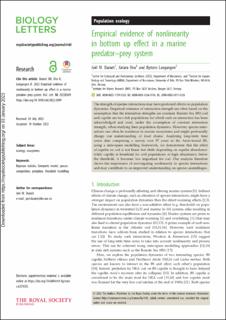| dc.contributor.author | Durant, Joël | |
| dc.contributor.author | Ono, Kotaro | |
| dc.contributor.author | Langangen, Øystein Ole Gahr | |
| dc.date.accessioned | 2023-01-10T13:45:10Z | |
| dc.date.available | 2023-01-10T13:45:10Z | |
| dc.date.created | 2022-11-03T11:48:41Z | |
| dc.date.issued | 2022 | |
| dc.identifier.citation | Biology Letters. 2022, 18 (11), . | |
| dc.identifier.issn | 1744-9561 | |
| dc.identifier.uri | https://hdl.handle.net/11250/3042415 | |
| dc.description.abstract | Strength of species interaction may have profound effects on population dynamics. Empirical estimates of interaction strength is often based on the assumption that the interaction strengths are constant. Barents Sea cod and capelin are two fish populations for which such interaction has been acknowledged and used, under the assumption of constant interaction strength, when studying their population dynamics. However, species interaction can often be non-linear in marine ecosystems and might profoundly change our understanding of food chains. Analysing 37 years long survey time series in the Arcto-Boreal Barents Sea with a state-space modelling framework, we demonstrate that the effect of capelin on cod is not linear but shifts depending on capelin abundance: while capelin is beneficial for cod population at high abundance, below the threshold, it becomes less important for cod. Our analysis therefore shows the importance of investigating non-linearity in species interaction and may contribute to an improved understanding on species assemblages. | |
| dc.description.abstract | Empirical evidence of nonlinearity in bottom up effect in a marine predator-prey system | |
| dc.language.iso | eng | |
| dc.title | Empirical evidence of nonlinearity in bottom up effect in a marine predator-prey system | |
| dc.title.alternative | Empirical evidence of nonlinearity in bottom up effect in a marine predator-prey system | |
| dc.type | Peer reviewed | |
| dc.type | Journal article | |
| dc.description.version | acceptedVersion | |
| dc.description.version | publishedVersion | |
| dc.source.pagenumber | 6 | |
| dc.source.volume | 18 | |
| dc.source.journal | Biology Letters | |
| dc.source.issue | 11 | |
| dc.identifier.doi | 10.1098/rsbl.2022.0309 | |
| dc.identifier.cristin | 2068553 | |
| dc.relation.project | Norges forskningsråd: 276730 | |
| dc.relation.project | Norges forskningsråd: 280467 | |
| cristin.ispublished | true | |
| cristin.fulltext | postprint | |
| cristin.fulltext | original | |
| cristin.qualitycode | 2 | |
